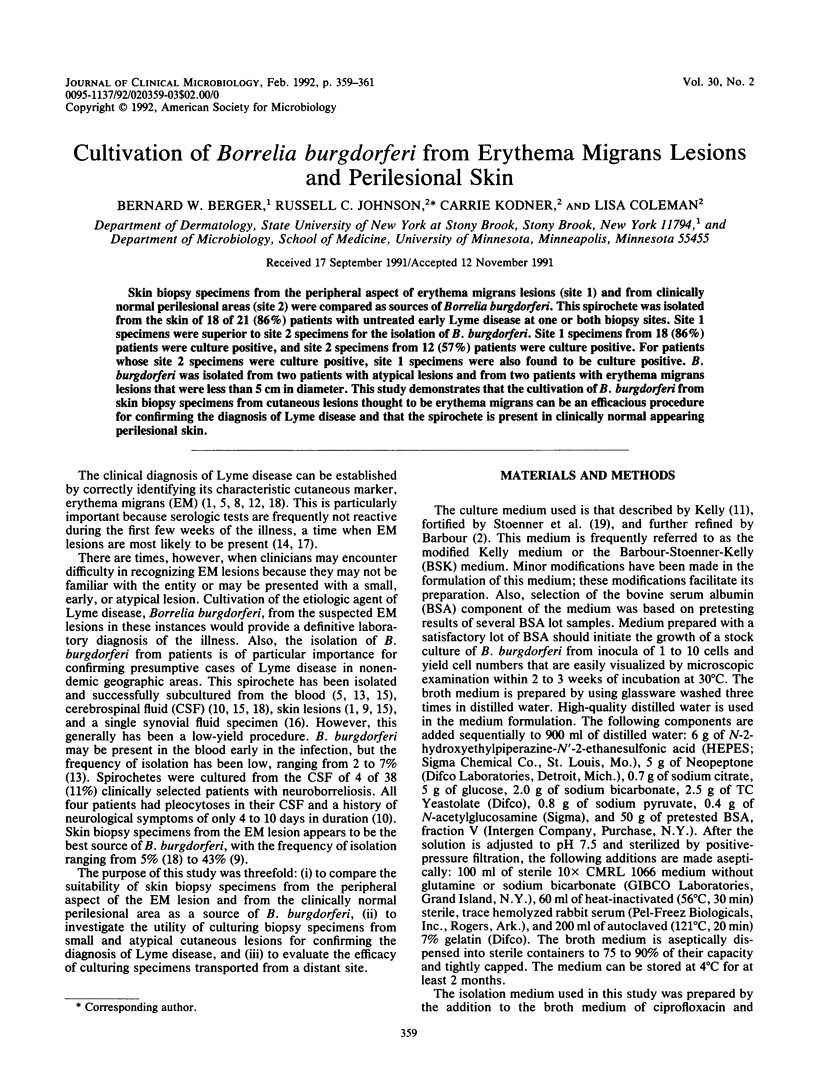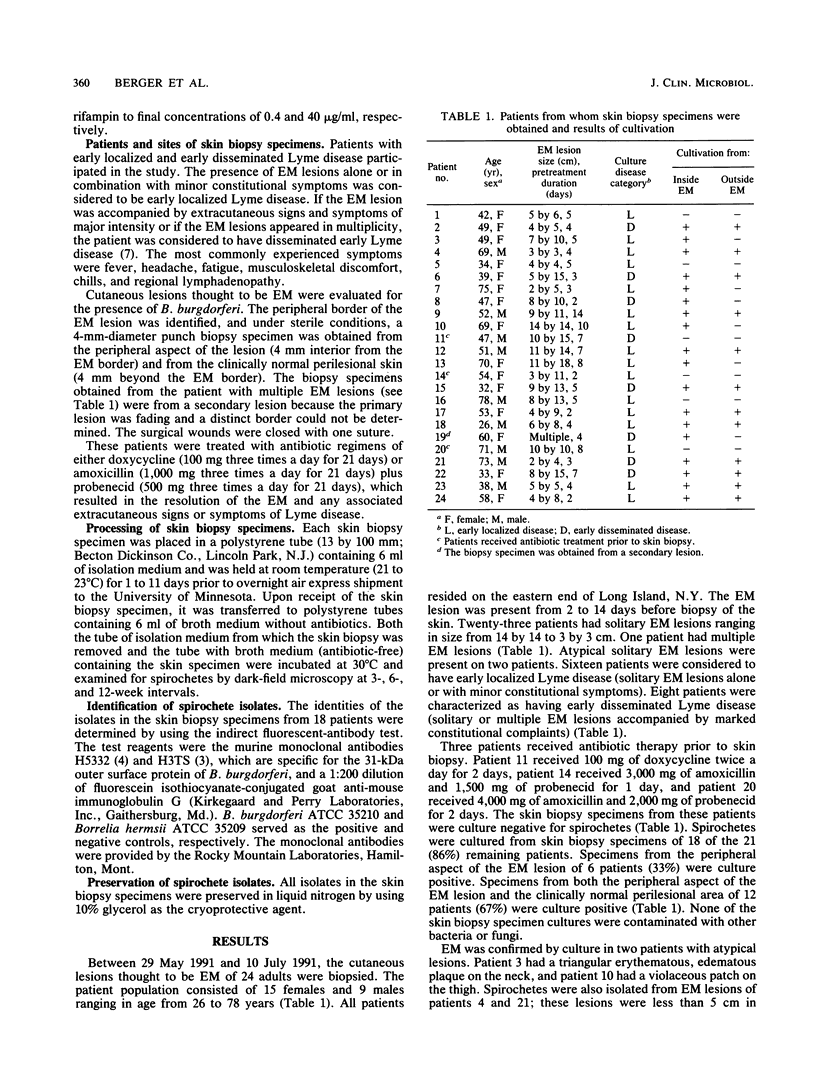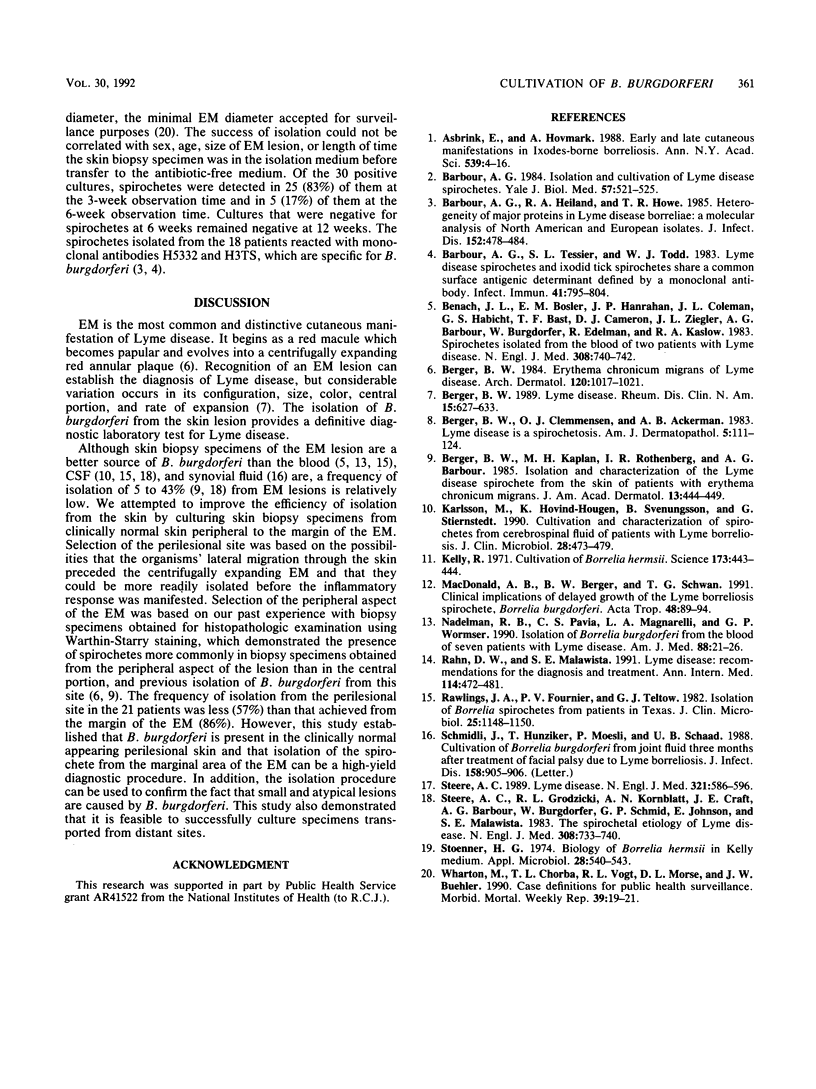Abstract
Skin biopsy specimens from the peripheral aspect of erythema migrans lesions (site 1) and from clinically normal perilesional areas (site 2) were compared as sources of Borrelia burgdorferi. This spirochete was isolated from the skin of 18 of 21 (86%) patients with untreated early Lyme disease at one or both biopsy sites. Site 1 specimens were superior to site 2 specimens for the isolation of B. burgdorferi. Site 1 specimens from 18 (86%) patients were culture positive, and site 2 specimens from 12 (57%) patients were culture positive. For patients whose site 2 specimens were culture positive, site 1 specimens were also found to be culture positive. B. burgdorferi was isolated from two patients with atypical lesions and from two patients with erythema migrans lesions that were less than 5 cm in diameter. This study demonstrates that the cultivation of B. burgdorferi from skin biopsy specimens from cutaneous lesions thought to be erythema migrans can be an efficacious procedure for confirming the diagnosis of Lyme disease and that the spirochete is present in clinically normal appearing perilesional skin.
Full text
PDF


Selected References
These references are in PubMed. This may not be the complete list of references from this article.
- Asbrink E., Hovmark A. Early and late cutaneous manifestations in Ixodes-borne borreliosis (erythema migrans borreliosis, Lyme borreliosis). Ann N Y Acad Sci. 1988;539:4–15. doi: 10.1111/j.1749-6632.1988.tb31833.x. [DOI] [PubMed] [Google Scholar]
- Barbour A. G., Heiland R. A., Howe T. R. Heterogeneity of major proteins in Lyme disease borreliae: a molecular analysis of North American and European isolates. J Infect Dis. 1985 Sep;152(3):478–484. doi: 10.1093/infdis/152.3.478. [DOI] [PubMed] [Google Scholar]
- Barbour A. G. Isolation and cultivation of Lyme disease spirochetes. Yale J Biol Med. 1984 Jul-Aug;57(4):521–525. [PMC free article] [PubMed] [Google Scholar]
- Barbour A. G., Tessier S. L., Todd W. J. Lyme disease spirochetes and ixodid tick spirochetes share a common surface antigenic determinant defined by a monoclonal antibody. Infect Immun. 1983 Aug;41(2):795–804. doi: 10.1128/iai.41.2.795-804.1983. [DOI] [PMC free article] [PubMed] [Google Scholar]
- Benach J. L., Bosler E. M., Hanrahan J. P., Coleman J. L., Habicht G. S., Bast T. F., Cameron D. J., Ziegler J. L., Barbour A. G., Burgdorfer W. Spirochetes isolated from the blood of two patients with Lyme disease. N Engl J Med. 1983 Mar 31;308(13):740–742. doi: 10.1056/NEJM198303313081302. [DOI] [PubMed] [Google Scholar]
- Berger B. W., Clemmensen O. J., Ackerman A. B. Lyme disease is a spirochetosis. A review of the disease and evidence for its cause. Am J Dermatopathol. 1983 Apr;5(2):111–124. [PubMed] [Google Scholar]
- Berger B. W. Erythema chronicum migrans of Lyme disease. Arch Dermatol. 1984 Aug;120(8):1017–1021. [PubMed] [Google Scholar]
- Berger B. W., Kaplan M. H., Rothenberg I. R., Barbour A. G. Isolation and characterization of the Lyme disease spirochete from the skin of patients with erythema chronicum migrans. J Am Acad Dermatol. 1985 Sep;13(3):444–449. doi: 10.1016/s0190-9622(85)70187-9. [DOI] [PubMed] [Google Scholar]
- Karlsson M., Hovind-Hougen K., Svenungsson B., Stiernstedt G. Cultivation and characterization of spirochetes from cerebrospinal fluid of patients with Lyme borreliosis. J Clin Microbiol. 1990 Mar;28(3):473–479. doi: 10.1128/jcm.28.3.473-479.1990. [DOI] [PMC free article] [PubMed] [Google Scholar]
- Kelly R. Cultivation of Borrelia hermsi. Science. 1971 Jul 30;173(3995):443–444. doi: 10.1126/science.173.3995.443. [DOI] [PubMed] [Google Scholar]
- MacDonald A. B., Berger B. W., Schwan T. G. Clinical implications of delayed growth of the Lyme borreliosis spirochete, Borrelia burgdorferi. Acta Trop. 1990 Dec;48(2):89–94. doi: 10.1016/0001-706x(90)90047-4. [DOI] [PubMed] [Google Scholar]
- Nadelman R. B., Pavia C. S., Magnarelli L. A., Wormser G. P. Isolation of Borrelia burgdorferi from the blood of seven patients with Lyme disease. Am J Med. 1990 Jan;88(1):21–26. doi: 10.1016/0002-9343(90)90122-t. [DOI] [PubMed] [Google Scholar]
- Rahn D. W., Malawista S. E. Lyme disease: recommendations for diagnosis and treatment. Ann Intern Med. 1991 Mar 15;114(6):472–481. doi: 10.7326/0003-4819-114-6-472. [DOI] [PubMed] [Google Scholar]
- Rawlings J. A., Fournier P. V., Teltow G. J. Isolation of Borrelia spirochetes from patients in Texas. J Clin Microbiol. 1987 Jul;25(7):1148–1150. doi: 10.1128/jcm.25.7.1148-1150.1987. [DOI] [PMC free article] [PubMed] [Google Scholar]
- Schmidli J., Hunziker T., Moesli P., Schaad U. B. Cultivation of Borrelia burgdorferi from joint fluid three months after treatment of facial palsy due to Lyme borreliosis. J Infect Dis. 1988 Oct;158(4):905–906. doi: 10.1093/infdis/158.4.905. [DOI] [PubMed] [Google Scholar]
- Steere A. C., Grodzicki R. L., Kornblatt A. N., Craft J. E., Barbour A. G., Burgdorfer W., Schmid G. P., Johnson E., Malawista S. E. The spirochetal etiology of Lyme disease. N Engl J Med. 1983 Mar 31;308(13):733–740. doi: 10.1056/NEJM198303313081301. [DOI] [PubMed] [Google Scholar]
- Steere A. C. Lyme disease. N Engl J Med. 1989 Aug 31;321(9):586–596. doi: 10.1056/NEJM198908313210906. [DOI] [PubMed] [Google Scholar]
- Stoenner H. G. Biology of Borrelia hermsii in Kelly medium. Appl Microbiol. 1974 Oct;28(4):540–543. doi: 10.1128/am.28.4.540-543.1974. [DOI] [PMC free article] [PubMed] [Google Scholar]


